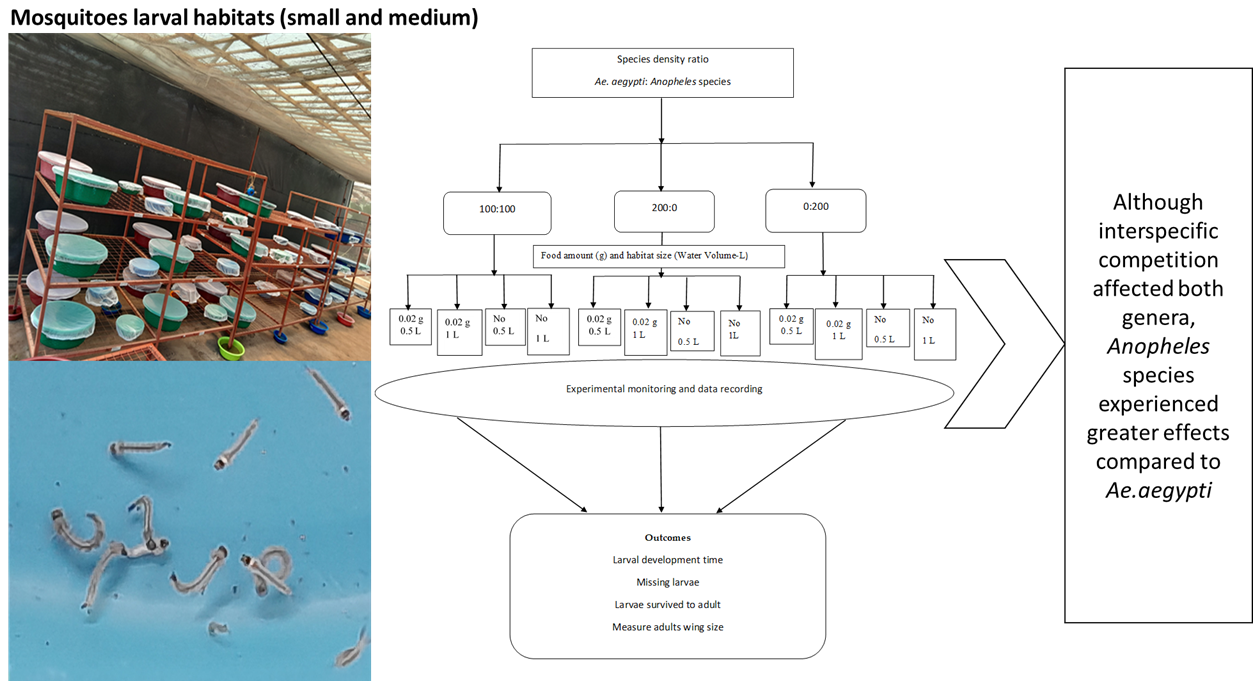The Interspecific Competition Between Larvae of Aedes aegypti and Major African Malaria Vectors in a Semi-Field System in Tanzania
How to cite: Lushasi, S. C.; Mwalugelo, Y. A.; Swai, J. K.; Mmbando, A. S.; Muyaga, L. L.; Nyolobi, N. K.; Mutashobya, A.; Mmbaga, A.; Kunambi, H. J.; Twaha, S.; Mwema, M. F.; Lwetoijera, D. W. The Interspecific Competition Between Larvae of Aedes aegypti and Major African Malaria Vectors in a Semi-Field System in Tanzania. Preprints 2024, 2024101309. https://doi.org/10.20944/preprints202410.1309.v1 Lushasi, S. C.; Mwalugelo, Y. A.; Swai, J. K.; Mmbando, A. S.; Muyaga, L. L.; Nyolobi, N. K.; Mutashobya, A.; Mmbaga, A.; Kunambi, H. J.; Twaha, S.; Mwema, M. F.; Lwetoijera, D. W. The Interspecific Competition Between Larvae of Aedes aegypti and Major African Malaria Vectors in a Semi-Field System in Tanzania. Preprints 2024, 2024101309. https://doi.org/10.20944/preprints202410.1309.v1
Abstract
Interspecific competition between mosquito larvae may affects adult vectorial capacity, potentially reducing disease transmission. It also influences population dynamics, cannibalistic and predatory behaviors. However, knowledge of interspecific competition between Ae. aegypti and Anopheles species is limited. The study examined interspecific competition between Ae. aegypti larvae and either An. arabiensis, An. gambiae, or An. funestus on individual fitness in semi-field settings. The experiments involved density combinations of 100:100, 200:0, and 0:200 (Ae. aegypti: Anopheles), reared with and without food, in small habitat (8.5 cm height × 15 cm diameter) with 0.5 litre and medium habitats (15 cm height × 35 cm diameter) with 1 litre of water. The first group received Tetramin® fish food (0.02 g), while the second group was unfed to assess cannibalism and predation. While, interspecific competition affected both genera, Anopheles species experienced greater effect, with reduced survival and delayed development, compared to Ae. aegypti. The mean wing lengths of all species were significantly small in small habitats in mixed population (p < 0.001). The presence of food reduced cannibalism and predation compared to its absence. These interactions have implications for diseases transmission dynamics and can serve as biological indicators to signal the impacts of vector control interventions.
Keywords
inter-specific competition; intra-specific competition; Aedes aegypti; An. arabiensis; An. gambiae; An. funestus; predation; cannibalism
Subject
Copyright: This is an open access article distributed under the Creative Commons Attribution License which permits unrestricted use, distribution, and reproduction in any medium, provided the original work is properly cited.
Comments (0)
We encourage comments and feedback from a broad range of readers. See criteria for comments and our Diversity statement.
Leave a public commentSend a private comment to the author(s)








